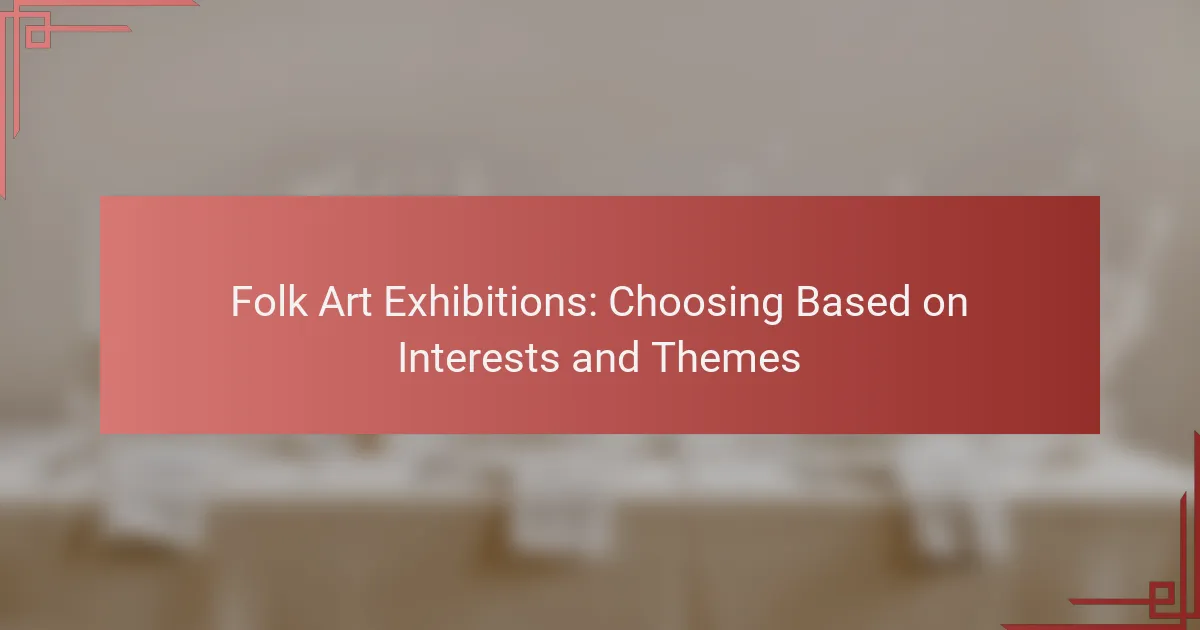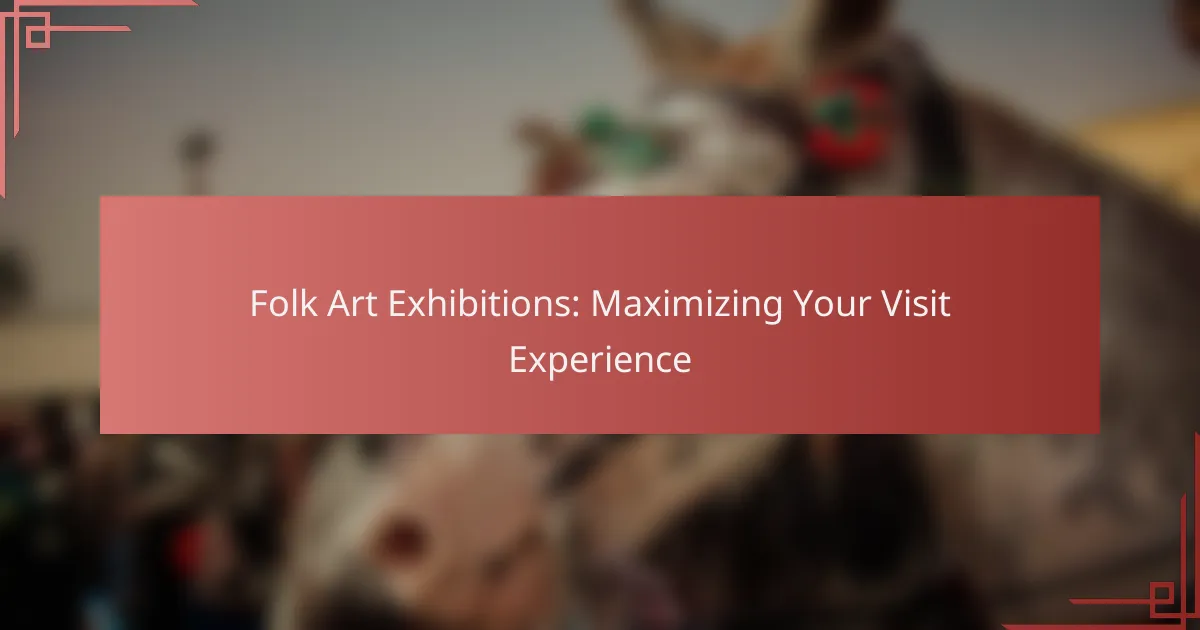Folk art workshops serve as a vibrant platform for community engagement, allowing individuals to connect through shared cultural practices and creative expression. By offering hands-on experiences in various traditional crafts, these workshops not only enhance creativity but also foster a deeper appreciation for cultural heritage, making them an invaluable addition to educational curricula.
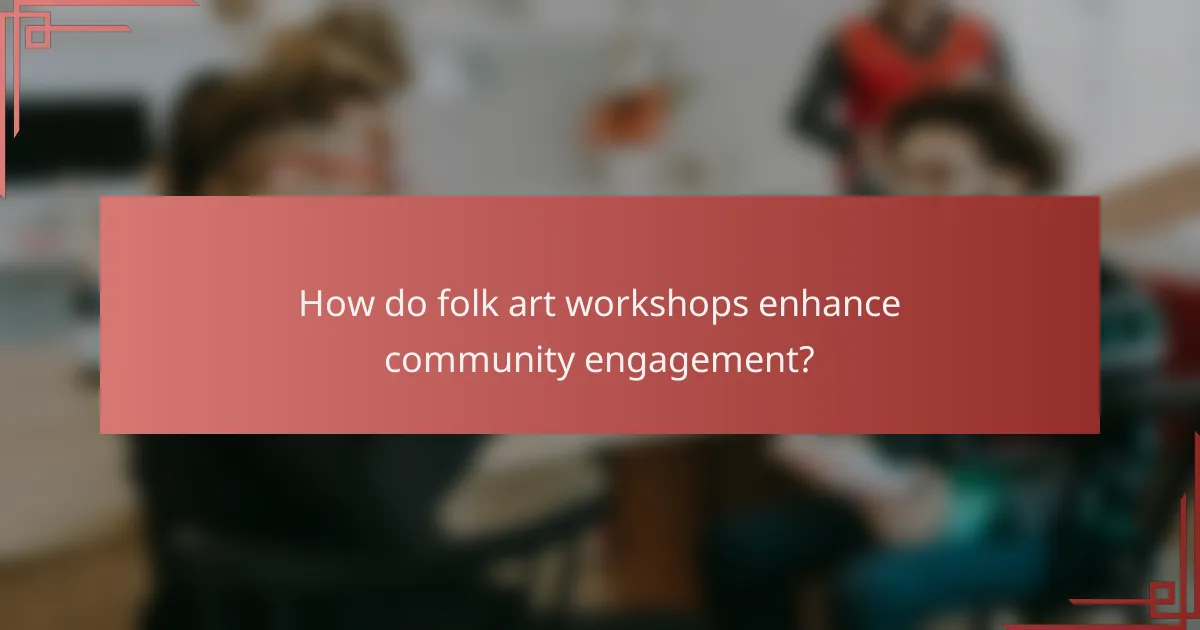
How do folk art workshops enhance community engagement?
Folk art workshops enhance community engagement by providing a platform for individuals to connect through shared cultural practices and creative expression. These workshops foster collaboration, allowing participants to learn from one another while building a sense of belonging within their community.
Fostering social connections
Folk art workshops create opportunities for individuals to meet and interact, breaking down social barriers. Participants often form friendships as they work together on projects, share stories, and celebrate their cultural heritage.
To maximize social connections, facilitators can encourage group activities and collaborative art-making. This approach not only enhances the learning experience but also strengthens community ties.
Encouraging cultural exchange
These workshops serve as a venue for cultural exchange, where participants can share their unique traditions and artistic techniques. This exchange enriches the experience for everyone involved, promoting understanding and appreciation of diverse backgrounds.
For effective cultural exchange, workshops can include demonstrations from local artisans or guest instructors who specialize in different folk art forms. This not only diversifies the learning experience but also highlights the richness of the community’s cultural tapestry.
Building local identity
Folk art workshops contribute to building a strong local identity by celebrating regional traditions and craftsmanship. Participants often take pride in creating art that reflects their community’s history and values, reinforcing a collective sense of belonging.
To strengthen local identity, workshops can focus on traditional techniques specific to the area, such as pottery styles or textile patterns unique to the region. This not only preserves cultural heritage but also encourages participants to share their creations with the wider community, fostering pride and recognition.
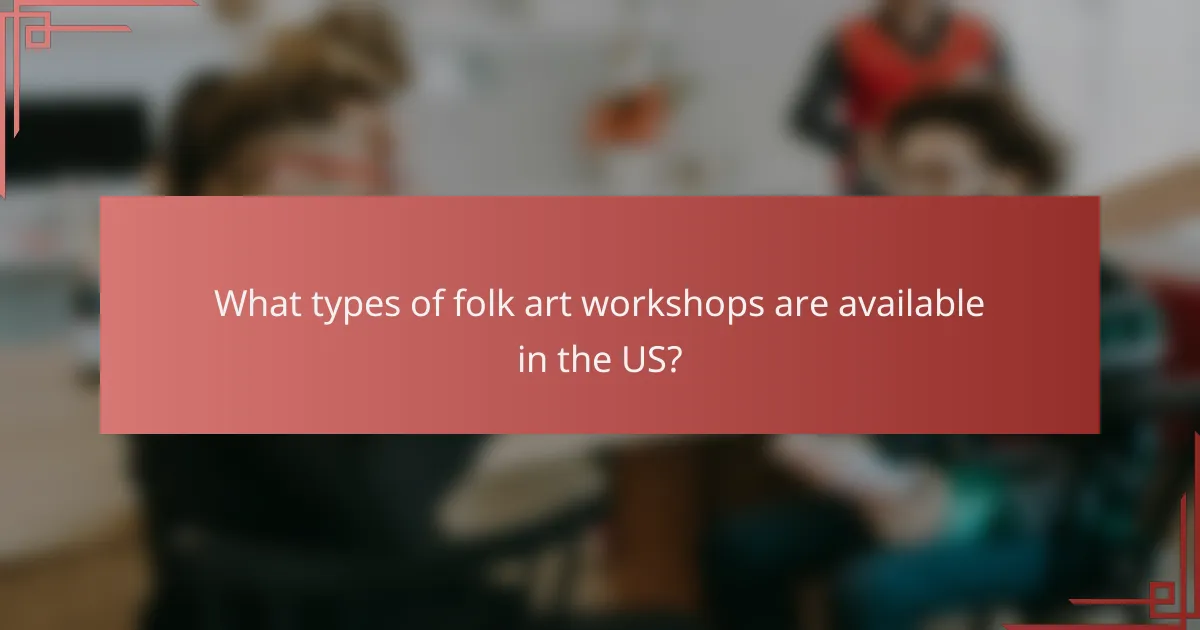
What types of folk art workshops are available in the US?
In the US, various folk art workshops cater to different interests, including traditional crafts, textile arts, and woodworking. These workshops provide hands-on experiences that enhance creativity and cultural appreciation.
Traditional crafts workshops
Traditional crafts workshops focus on skills passed down through generations, such as pottery, basket weaving, and leatherworking. Participants learn techniques that reflect regional heritage and often use local materials.
These workshops typically last from a few hours to several days, depending on the complexity of the craft. Beginners are welcome, and many instructors provide all necessary materials, making it easy to get started.
Textile art classes
Textile art classes explore various techniques, including quilting, embroidery, and weaving. Participants can create unique pieces while learning about the cultural significance of different textile traditions.
Classes may range from short introductory sessions to extensive courses lasting several weeks. It’s advisable to check if the class provides materials or if participants need to bring their own, as this can affect costs.
Woodworking sessions
Woodworking sessions teach participants how to craft items from wood, such as furniture, toys, or decorative pieces. These workshops often emphasize safety and proper tool usage, making them suitable for all skill levels.
Sessions can vary in length, with some lasting a few hours and others spanning multiple days. Participants should consider the type of project they want to undertake, as this will influence the tools and materials needed.
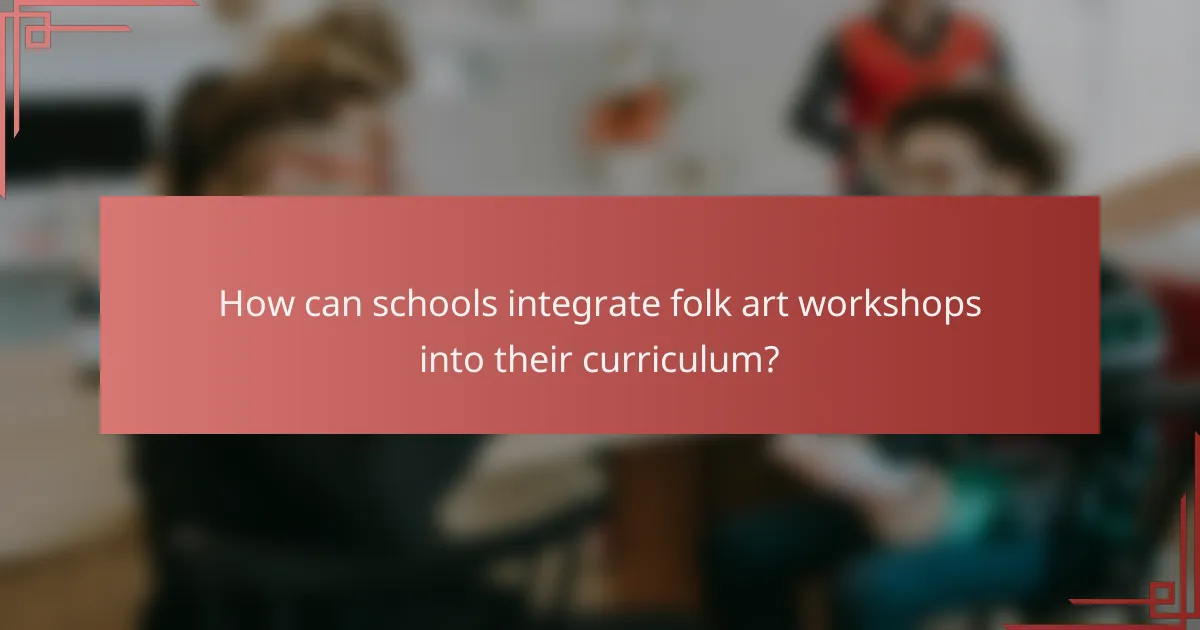
How can schools integrate folk art workshops into their curriculum?
Schools can effectively integrate folk art workshops into their curriculum by incorporating them as interactive learning modules that enhance creativity and cultural awareness. These workshops can be designed to align with existing subjects, fostering a deeper understanding of both artistic techniques and cultural history.
Hands-on learning experiences
Folk art workshops provide students with hands-on learning experiences that engage them in practical skill development. Activities such as pottery, weaving, or painting allow students to explore traditional techniques while fostering creativity and self-expression.
To implement these workshops, educators can schedule sessions during art classes or as part of cultural studies. For example, a week-long workshop could focus on a specific folk art form, culminating in a student exhibition to showcase their work.
Cross-disciplinary projects
Integrating folk art workshops into cross-disciplinary projects can enhance students’ learning by connecting art with history, geography, and social studies. For instance, a project could involve researching the origins of a specific folk art style and creating a piece inspired by that tradition.
Teachers can collaborate to design these projects, ensuring that students gain a comprehensive understanding of the cultural context behind the art. This approach not only enriches the learning experience but also encourages teamwork and critical thinking.
Community involvement opportunities
Community involvement is a key aspect of integrating folk art workshops, as it allows students to connect with local artisans and cultural heritage. Schools can partner with local artists to lead workshops, providing students with authentic experiences and insights into the art form.
Additionally, organizing community events where students can display their work fosters a sense of pride and belonging. Schools might consider hosting art fairs or exhibitions that invite families and community members to participate, further enriching the educational experience.
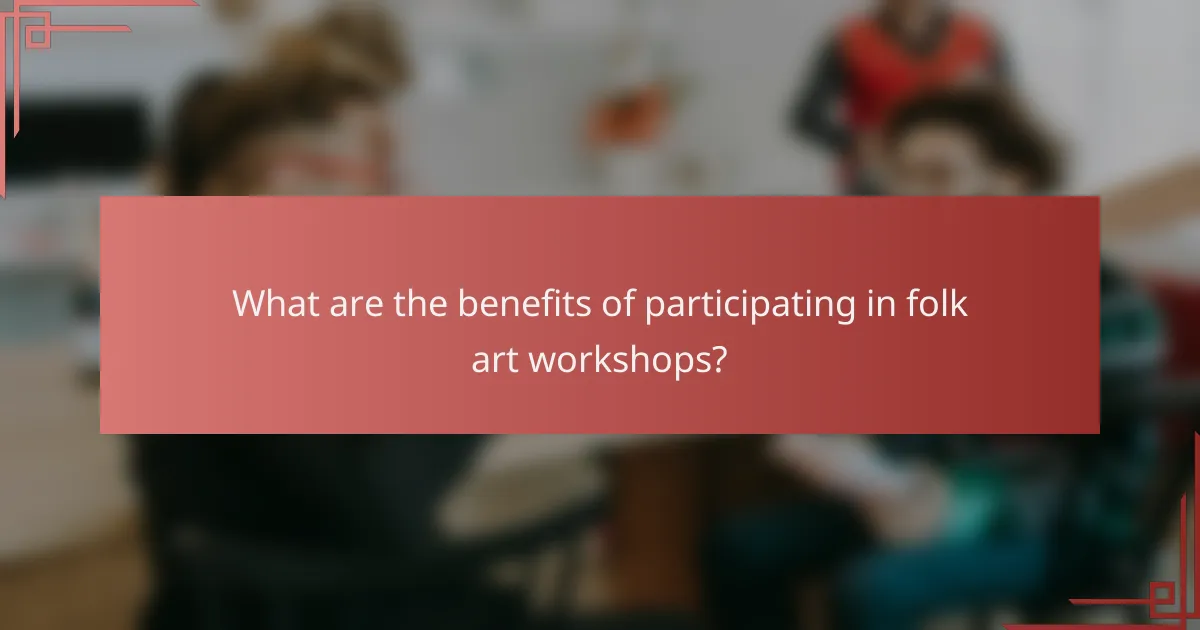
What are the benefits of participating in folk art workshops?
Participating in folk art workshops offers numerous benefits, including skill enhancement, increased creativity, and therapeutic advantages. These workshops provide hands-on experiences that foster personal growth and community engagement.
Skill development
Folk art workshops are excellent for developing various skills, such as painting, weaving, or pottery. Participants often learn traditional techniques that can be applied in their own artistic endeavors, enhancing both their craftsmanship and confidence.
Workshops typically cater to different skill levels, allowing beginners to grasp the basics while more experienced artists can refine their techniques. This structured learning environment encourages participants to practice and improve their abilities over time.
Boosting creativity
Engaging in folk art workshops stimulates creativity by exposing participants to new ideas and artistic expressions. The collaborative atmosphere encourages sharing and inspiration, which can lead to innovative projects and personal artistic breakthroughs.
By experimenting with different materials and techniques, individuals can discover unique styles and approaches to art. This exploration not only enhances their creative thinking but also fosters a sense of individuality in their work.
Therapeutic effects
Folk art workshops can have significant therapeutic benefits, providing a relaxing and enjoyable outlet for stress relief. Engaging in creative activities has been shown to reduce anxiety and improve overall mental well-being.
Participants often find that the act of creating art allows them to express emotions and thoughts that may be difficult to articulate otherwise. This therapeutic aspect can be particularly beneficial for individuals dealing with trauma or seeking a sense of community and belonging.

How to choose the right folk art workshop for your needs?
Choosing the right folk art workshop involves assessing your skill level, evaluating the duration of the workshop, and considering the expertise of the instructor. These factors will help ensure that the workshop aligns with your learning goals and provides a fulfilling experience.
Assessing skill level
Understanding your current skill level is crucial when selecting a folk art workshop. Workshops typically cater to beginners, intermediates, or advanced artists, so identifying where you fit can enhance your learning experience. For instance, a beginner may struggle in an advanced class, while an expert might find a beginner workshop unchallenging.
Consider reviewing the workshop description or contacting the organizer to clarify the expected skill level. This will help you avoid frustration and ensure that you gain the most from the experience.
Evaluating workshop duration
The duration of a folk art workshop can significantly impact your learning. Workshops can range from a few hours to several days, and longer sessions often allow for deeper exploration of techniques. If you have limited time, a shorter workshop might be more suitable, but ensure it covers the essential skills you want to learn.
Think about your schedule and how much time you can realistically commit. A weekend workshop may be ideal for those with busy weekdays, while a week-long retreat could provide an immersive experience for dedicated learners.
Considering instructor expertise
The expertise of the instructor can greatly influence the quality of the workshop. Look for instructors with a strong background in folk art, relevant teaching experience, and positive reviews from past participants. An experienced instructor can provide valuable insights and personalized feedback that can enhance your skills.
Researching the instructor’s portfolio or previous work can also give you an idea of their style and approach. If possible, attend a workshop led by someone whose work resonates with you to ensure a more engaging and relevant learning experience.
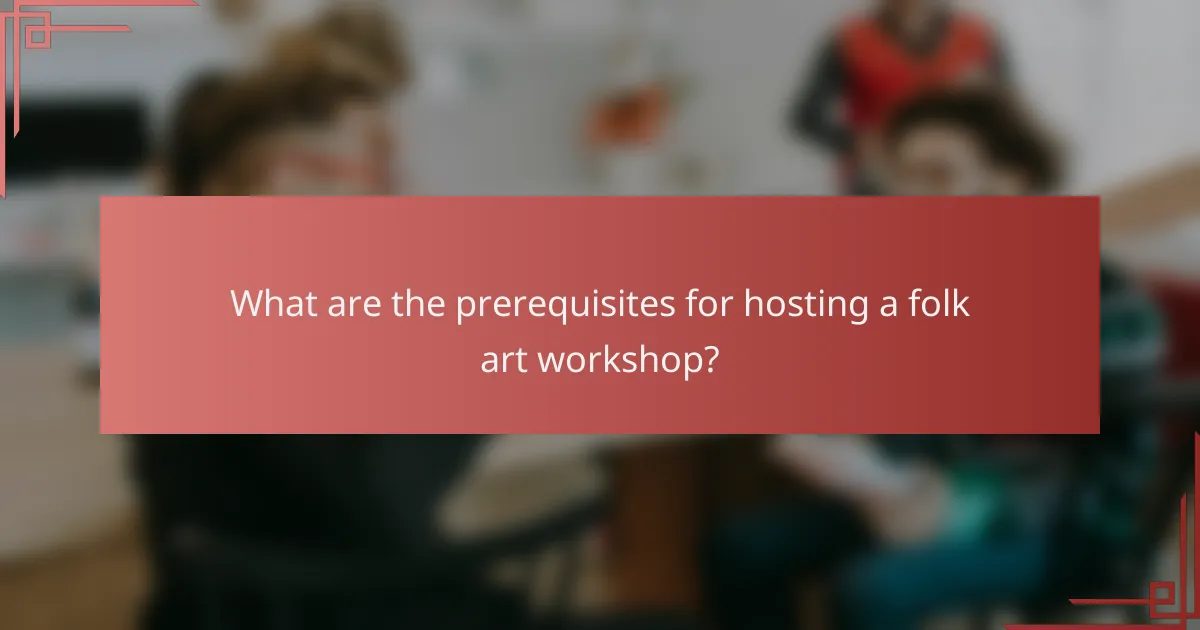
What are the prerequisites for hosting a folk art workshop?
To host a folk art workshop, you need to consider several key prerequisites, including space, materials, and participant engagement strategies. Ensuring you have the right environment and resources is essential for a successful experience.
Space and materials requirements
Choosing the right space is crucial for a folk art workshop. Ideally, the venue should be spacious enough to accommodate participants comfortably, with good lighting and ventilation. A community center, art studio, or even an outdoor area can work well, depending on the art form being taught.
Materials will vary based on the specific folk art being explored. Common supplies might include paints, brushes, fabrics, or traditional tools relevant to the craft. It’s advisable to prepare a checklist of necessary items and ensure you have enough for all participants, typically allowing for a few extra in case of mistakes or accidents.
Consider the budget for materials, as costs can range from modest to significant depending on the complexity of the art form. For example, basic painting supplies may cost around 20-50 USD per participant, while specialized tools for crafts like pottery could be higher. Always plan ahead to avoid last-minute shortages or overspending.

